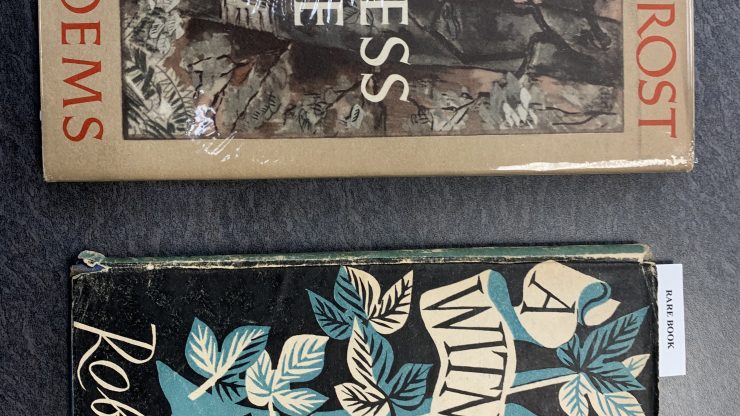Poetry in the Archives by Jim Hetherington – February 26, 2019
back to the Special Collections Blog

Robert Frost, a prominent poet, and award-winning poet Pulitzer Prize recipient earned his niche in short lyric artistry. Notably, the man who pulled together a patriotic poem he read at John F. Kennedy’s inauguration in 1961 on January 20th, “The Gift Outright” marks a time when he was well heard towards the end of his career at 87-years-old. He endured a lot of hardship and committed to writing as an outlet. After Frost’s daughter Marjorie’s death in 1934, his wife’s death in 1938, and his son Carol’s suicide in 1940, A Witness Tree published. Despite these losses, his knack for poetry remained resilient, and he fell in love with his secretary Kay Marrison, who officially lent insight for the remainder of his love life poems.
Before me are two separate editions of A Witness Tree. Both repay homage to his formal partner K.M. “FOR HER PART IN IT” as his true love. The larger edition printed in 1942, whereas the second edition (slightly small) was published in 1943. Both are covers that have trees on them. One may note how the 1943 cover is not so stark and barren as the 1942 cover’s tree. Either/or, the editions are teeming with poems organized into five chapters. Before embarking on a Frost poetry spree, two poems share a page. Setting the tone for what’s to come, “BEECH” and “SYCAMORE” appear, both species of tree and written by The Moodie Forester and The New England Primer respectively. Then the chapters unfold as such: ONE OR TWO, TWO OR MORE, TIME OUT, QUANTULA, and OVER BACK. Please note “quantula” is a medium-sized, air-breathing, tropical land snail. Also, either book contains all his A Witness Tree poems. The notable contrasts when analyzed book to book are the page size, text format, and book jacket that introduce and conclude either book.
Every poem has varying grammar structure. Each line begins with a capital letter, and the line breaks eventually lead to a period’s end. Some lyrics even have noted sections in Greek numerically. Culminating with in-time witty rhyming and provoking titles, Frost published a collector’s item. With the featured poems: “THE GIFT OUTRIGHT,” “A QUESTION,” and “THE SILKEN TENT,” Frost is housing an impressive selection of a legacy.
Heading the TWO OR MORE chapter, “THE GIFT OUTRIGHT” exuberantly timelines how the American colonies were oppressed by England… the gift being land and how malleable both it and the evolving colonies were, ultimately prompting their own flourish.
In QUANTULA, “A QUESTION” is no question, but a sentence with internal rhyming, sprucing up the coined idea that we are confronted with trials and tribulations, yet these problems are worth it to have been born.
The first chapter, ONE OR TWO’s “THE SILKEN TENT” paints a picture of a tent engulfed in nature. It symbolizes how one we are with nature, her beauty and how when we retreat to said nature we realize how apart of the picture we are.
A Witness Tree represents the Robert Frost Collection in a way as it marks a segment of life. Artists working are influenced by memories of loved ones, adventure, and lifestyle changes. Not many professions are inclusive of that kind of ebb and flow. Things like that imbue our lives and shape how we function, what we do, and who we are. Frost’s A Witness Tree capitalizes on how Mother Nature is here for us. All life on Earth goes through cycles low and high, interacting with its neighbor (us) all the while seeing it through as our guide.